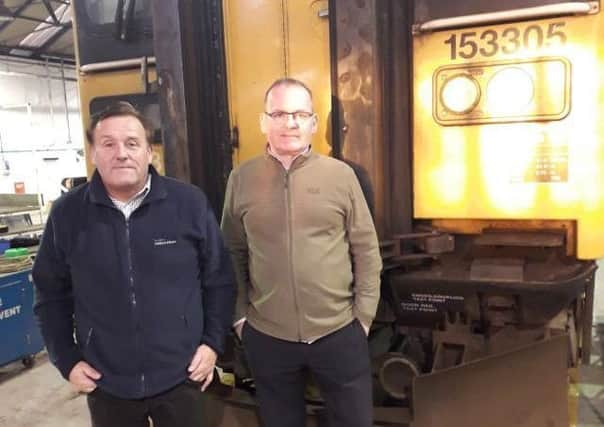John Yellowlees: Kilmarnock’s renewal on track with rail upgrade programme


For each new train or station there are many more refurbishments taking place. Many of Scotland’s stations were built in Victorian times and continue to be refurbished to modern standards. What can look like new trains to passengers are often refurbishments of ageing trains. To better understand how the supply chain for refurbishing works, the Chartered Institute of Logistics and Transport recently went behind the scenes at Brodie Engineering in Kilmarnock.
Brodie Engineering was founded 22 years ago, operating initially out of industrial buildings in Irvine. When Network Rail decided to downsize accommodation for track machines, an opportunity arose in 2010 to move into their rail-connected plant maintenance depot at Kilmarnock.
Advertisement
Hide AdAdvertisement
Hide AdThe accommodation size has since been doubled to provide cover for 14 23-metre vehicles, with room for ten more in the yard. Brodie now employs 83 permanent staff, including 17 apprentices, with several staff on a mature apprentice scheme, making it one of the largest employers in an area where jobs growth is much needed.
Staff have skills in paint spraying, lifting, fabrication and sheet metalwork. Investment includes a traverser to move vehicles across the shed and a shunter to shift them round the yard. With mechanical and electrical design facilities, Brodie can undertake product engineering, three-dimensional modelling and regulatory compliance. As well as internal and external overhauls, the business carries out accident and corrosion repairs, including work off-site, and has recently been upgrading vehicles to meet the needs of people with reduced mobility.
Refurbishing trains is also helping to regenerate the area. The investment by Brodie Engineering has played a key part in the revival of Kilmarnock. Refurbishment is often better able to make good use of existing resources than building new, including drawing on skills in the local workforce. In Kilmarnock the ability to repurpose declining facilities also makes the most of existing assets before they decay.
Brodie Engineering’s first big contract for ScotRail was refurbishment and new liveries for the 40-strong Class 334 electric fleet. Its most prestigious order was repurposing ten Irish carriages for the luxury train Belmond Grand Hibernian. Brodie has helped Caledonian Sleeper to commission its new Mark 5 fleet from Spanish trainbuilder CAF, and also undertakes bespoke design and manufacture work for specialist equipment, including rail handling machines for both Network Rail and the Glasgow Subway. A forthcoming task for ScotRail will be to convert five single-car Class 153 diesel trains now at Kilmarnock to carry bicycles and other sporting equipment on Highland routes for which concept designs have been prepared, showing a seating area, catering facilities and space for 20 bikes with flexible storage for skis.
Refurbishment projects face many uncertainties. Opening up vehicles that have experienced daily wear and tear over many years can identifymany unexpected problems. Understanding the history of vehicles and giving them new life has long been popular within the rail industry. The Class 153 trains shortly to be refurbished played a notable part in Kilmarnock’s railway history.
British Rail’s decision 25 years ago to reform all but a handful of the former two-car Class 155 fleet as single-car trains enabled the town’s other, much longer-established rail refurbishment business Andrew Barclay (now part of Wabtec), to build new premises in the town.
Its previous home, the Caledonia Works, was then developed by privately-owned property investment and development company KLIN Group into the Barclay House development, which transformed an industrial office block to a complex of 100 apartments, a third of them for rent on a fully serviced and furnished basis.
Space was also found to honour Kilmarnock’s railway past with a glass-fronted heritage centre to house Drake, an industrial steam locomotive built by Barclay in the 1940s.
Advertisement
Hide AdAdvertisement
Hide AdThe new needs of Scotland’s railways require cleaner trains and new requirements for the use of space. A reduction in seating capacity has been necessary due to the need for more accessible toilet facilities on the Class 153s. There are also new needs for carriages to be used by ScotRail for carrying bikes. The modern Wabtec works is busy refurbishing high speed train carriages for ScotRail’s Inter7City sets that will be deployed on long-distance internal routes. Diesel emissions from high speed trains continue to be controversial, so refurbishment must look for innovative ways to bring vehicles up to modern emission standards.
Across Scotland, stations provide a unique historic monument to our industrial heritage. In Kilmarnock the award-winning work of the Kilmarnock Station Railway Heritage Trust has found community uses for empty rooms, with similar approaches making stations business and community hubs across the country. The new Ayrshire College sits alongside Kilmarnock station and includes a Foundation Apprenticeship in civil engineering to help develop the growing skills base in the area.
As the throwaway culture of the 20th century continues to be replaced by better approaches to make good use of all the country’s assets, Kilmarnock shows what can be achieved. The supply chain behind the railway industry is helping to create new value in the economy of Ayrshire, and Kilmarnock can truly be said to be experiencing a rail-led renaissance.
John Yellowlees, chair CILT Scotland.